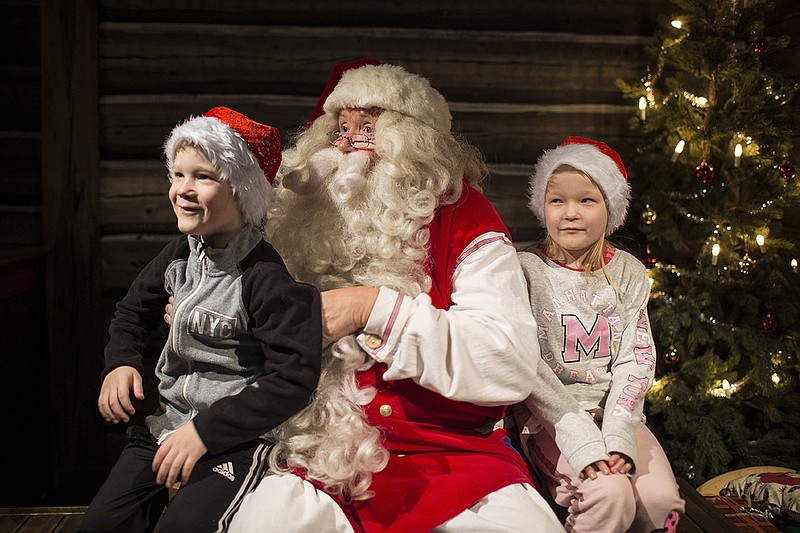ROVANIEMI, Finland - Here in Santa Claus Village, near the Arctic Circle, is the self-anointed "Official Santa," a Finn who refuses to give his real name, insisting he is actually Mr. Claus.
A couple of hundred yards away in a competing venue is Second Santa, whose real name is Kari Eskeli, 65, also a Finn. As soon as Christmas is over, he goes back home to the warmth of the Spanish Canary Islands. "I can't wait," he chuckles at the end of a long recent day of receiving supplicants. "Ho ho ho."
And then there's Evil Santa, as he calls himself, an outspoken raconteur holding forth in his son's busy souvenir shop just downstairs from Official Santa's grotto.
"This place is exploding now; it's really taking off," says Wolfgang Kassik, an Austrian business consultant with a long gray, all-natural beard, who is married to a Finn. "Personally, though, I don't like kids."
That could be a problem.
At this time of year, around 20 airliners a day, chartered and scheduled, land here in the capital of Finnish Lapland, disgorging families from scores of countries and bringing wide-eyed children to a reliably snowy place that is, for youngsters at least, a convincing re-creation of the North Pole (which is actually 1,600 miles north), complete with reindeer-drawn sleighs, staff in elfin dress and an official Finnish government "Santa's post office."
The dedicated Santa postal code of 96930 attracts half a million letters a year.
While no more real than the Santa impersonators' beards, Rovaniemi's claim to be the base of the one and only true Santa is nonetheless a triumph of marketing, so much so that the town has trademarked its rubric, "The Official Hometown of Santa Claus."
And for those who fret about the growing secularization of Christmas, they need only drop in here to confirm some of their worst fears.
Rumor has it there is a crèche somewhere in Santa Claus Village, but finding it is a challenge.
Despite temperatures in the single digits Fahrenheit - and nights now 22 hours long - 330,000 people from 180 countries, according to current figures, come to visit Santa, purchase 50 euro ($60) photos with him and patronize the dozens of Christmas trinket shops.
That nearly equals the combined total of reindeer (200,000) and people (180,000) in Lapland. Tourism growth this year in Rovaniemi (population 50,000) is 25 percent, says Sanna Karkkainen, the managing director of Visit Rovaniemi, the tourist board.
"We added 1,000 bed places just this Christmas season," she says.
Many of the tourists are neither Christians nor even from countries that celebrate Christmas. The largest single group of visitors are Chinese, who typically come without their children because there are no school holidays this time of year in China.
Fifty years ago, travel marketers got the idea to attract tourists to remote Lapland and settled on Rovaniemi for its train station and airport. For many years, though, the Santa Claus attraction jostled for visitors with tours to see the Northern Lights or go on reindeer safaris. Most of those who came were from countries with a strong Christmas tradition, bringing children along on the ultimate Santa's Grotto experience.
Barry and Leanne Smyth, from Ireland, brought their daughters, Lauren, 9, and Jodie, 4, here earlier this month, after a box of presents arrived at their house early with a note inside from Santy (as they know him in Ireland), inviting the girls to visit him in person. They found a flight to Helsinki, then all four crammed into a compartment with two beds on the overnight train to Rovaniemi, 500 miles to the north.
"We didn't sleep a wink," Smyth, an accountant, says. "But the girls loved it." The girls thanked Santa for his invitation (the parents exchanged a furtive glance) and asked, as many children do these days, for a slime factory.
No amount of commercialization can wipe the Christmas wonder from a child's eyes. For most of the youngsters coming through, Rovaniemi gives them a thoroughly convincing spectacle, from real igloos and ice furniture outside the downtown shopping mall, to tastefully done log-cabin style towers at the Santa village.
In recent years, Santa tourism has grown so drastically that "it's like everyone is building a hotel," says Tian Zhang, who came here from China to study for her master's degree. Now an entrepreneur and married to a Finn, she is in charge of one of the new hotels, the first Chinese-financed one. It opened five months ago and is already running at full occupancy, she says.
At the Rovaniemi Lutheran Church where the local pastors, Topi Litendahl and Elina Rask-Litendahl, work, Christmas Eve services are in several languages, including English, Hebrew and Arabic, just in case any tourists want to stop by. Every year only a couple of dozen do, about the only visible religious aspect to the tourist juggernaut.
"The Santa Claus of tourism and the Christmas of Christian faith, they can coexist quite nicely," Rask-Litendahl says.
